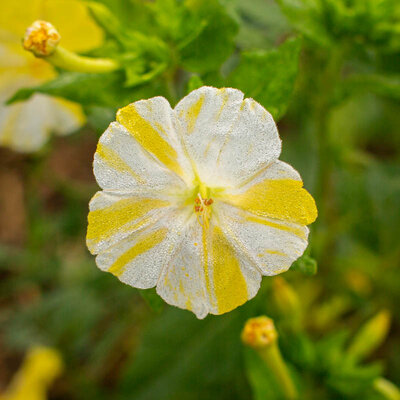
Marbles Yellow White - Belles de nuit
This variety can reach 50 cm in height and produces an abundance of yellow, white or bicolored flowers for several weeks, blooming in the evening and offering a powerful fragrance.
This cold-weather perennial keeps well from one year to the next, provided it is not subjected to heavy frosts. In regions with cold climates, dig up the tubers and overwinter them in a frost-free, sheltered place, then divide them and put them back in the ground in spring.
This species has anti-inflammatory, antiviral, antibacterial, antifungal, antispasmodic, diuretic, purgative, vulnerary and aphrodisiac qualities.
Discover it on the Kokopelli blog: "Les Belles de Nuit, et autres Mirabilis: des Merveilles de la Pharmacopée et de la Magiacopée Familiales".
These products may also be of interest to you
in the ground, in bucket
Sow in pots, under cover, in stacks of 2 to 3 seeds. Transplant with the whole clod once the last frosts have passed. To sow directly in the ground, wait for the soil to warm up and sow in stacks of 2 to 3 seeds, 40 cm apart in all directions.
This cold-weather perennial can be kept from one year to the next, provided it is not subjected to heavy frosts. In regions with cold climates, dig up the tubers and overwinter them in a frost-free, sheltered place, then divide them and put them back in the ground in spring.
March, April
May, June
June, July, August, September, October
in the ground, in pot
semi-shade, sunny
medium
coast, humus, sandy
drained, reheated
Mirabilis jalapa
15 seeds
Yellow, White
fragrance
50 cm
The species is called "Gulambasa" in Ayurvedic medicine and "Gul e Abbas" in Unani medicine. The leaves are used as anti-inflammatory, anti-viral, anti-bacterial, anti-fungal, anti-spasmodic... In the Himalayas and Pakistan, they are also used to treat jaundice and hepatitis. As for the roots, they are used for their diuretic, purgative and vulnerary - and aphrodisiac - virtues. In Nepal, Traditional Medicine also uses the roots as an aphrodisiac and purgative. A paste is made from them to treat scabies and muscular pathologies. Root juice is prescribed - 4 teaspoons twice a day - to treat diarrhoea and fevers. For menstrual problems, a paste is made with corn flour and baked. The leaves are considered diuretic. In Traditional Chinese Medicine, Mirabilis jalapa is called "Zhu Fan Hua Tou" and has been used to treat wounds, constipation, diabetes, pathologies of the urino-genital system and to fortify blood flow and harmonize cardiac function. The dosage is 3 to 9 grams of root decoction per day. In Mexico, the plant is traditionally used for abdominal colic, diarrhoea, contusions, bites, wounds, muscular pain, vaginal pathologies... The dosage is 8 to 9 g of root decoction per day. See Xochi's article: Les Belles de Nuit, et autres Mirabilis: des Merveilles de la Pharmacopée et la Magiacopée Familiales.






